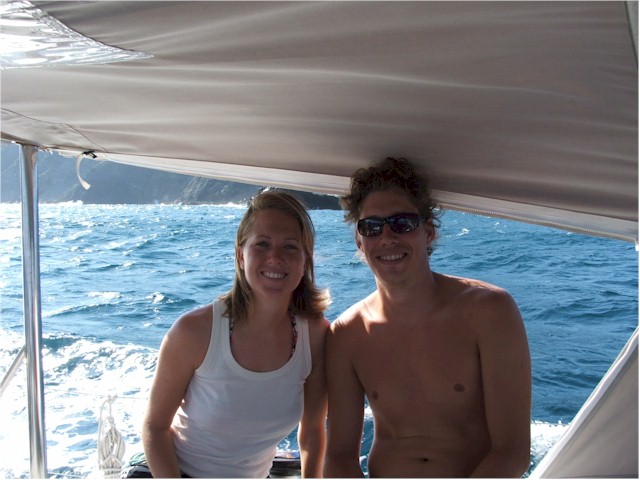|
conditions - so easy that it was possible
to unblock the toilet hose! (tough work for both captain and admiral).
Ahead of us were the Andes with snow on the tops as we steered in the
direction of the Five Bays. The wind was getting stronger, waves bigger
- the nervousness also increased! Getting closer to the third Bay we couldn't
identify if there was a rock or a boat at the beach. However it was a
boat - as Keith hoped. Things were getting calmer. We dropped the anchor
there next to the beach. We had arrived at the coast of Colombia!
But the Andes had their own wind tunnel effects;
every two minutes the "woomphs", as called by Keith, came over
the boat! You cannot imagine the power of that blast. For once there was
no electricity limit on Poco Andante! For Christine and Keith the
journey still wasn't finished - they had a hard anchor watch during the
night because of the wind - and let us sleep! How friendly. It was not
our intention to have just a holiday on board.
The National Park of Tayrona begins at the
Five Bays and is one of the most beautiful spots in the country. We spent
a wonderful time there, made our first contact with locals who invited
us for a shot of "aperitivo". We had dinner at the beach. In
this relaxing period waiting for calmer sea and winds we had time to observe
the region, meet some Colombians in a fantastic bay around the corner,
who explained us about the root of the Incas in Colombia. At night after
a delicious dinner, prepared by Keith, our chef de cuisine, we learnt
to play "Newmarket" with "funny money", we laughed
a lot and, as usual, Bigna won all the time.
We were ready for new explorations, so we
sailed to a "sixth" bay called Taganga, around the corner from
the Five Bays. It's a vacation place for Colombians - full of restaurants
on the beach and loud music everywhere. Exactly at beer o'clock it was
time for the first beer and a detailed planning for the day after. The
weather forecast should allow us to do the next step: crossing the big
delta of Rio Magdalena. Nice wind from the back was giving us an easy
sail, the waves were huge, around three meters. Gradually the color of
sea changed; from deep blue to washed out green, getting more and more
an ugly brown! It smelled earthy. Suddenly a borderline between the brown
and the blue sea indicated the end of the outflowing river. All the stories
about the danger of strong current and floating trees were passed easily
without any complication. Shortly after sunset the full moon rose and
we had enough light to pass a reef (which was not mentioned in our chart)
to drop the anchor in the lee of this reef, near the beach. In the morning
we realized that we were surrounded of hundreds of thatched sun shelters
waiting to give shade to their customers.
We went together to the beach to get an impression
of this "pueblo"; all the locals were running in our direction
to rent his shelter to us. Without local money we were stuck - until we
met the brother of "Jabba the Hutt" lying with his fat body
in a hammock, while giving commands to his employees. He gave us a high
exchange rate, better than the official rate; strange, but of course we
changed the money. We decided to eat a little snack and drink some beers
in his posada. We waited more than an hour for the "arepas"
we had ordered. But when we asked for the check, the ugly fat guy wanted
to have double the price we had agreed. With the combination of Swiss
tactic and English diplomacy we paid a fair price, but we decided to make
a quick departure as soon as possible! Days later we heard that this is
still a high crime and guerilla-region - who knows if "Jabba the
Hutt" is involved too?
Now the last section of our trip was before
us - a night sailing trip to our final destination, Cartagena. Strong
winds and huge rolling waves were responsible for our good speed; then
the last miles the wind was gone and the sea calmed down so that we motored
into Cartagena. We arrived in the harbor around 10 o'clock on the 13th
of January. The marina was full of cruisers who intend to sail further
to Panama. The colonial city is famous for its beauty and history. The
old part is surrounded by a wall and a chain of forts. Inside the wall
are small streets with restaurants, souvenir shops, fruit markets and
street artists.
We are proud to have sailed that inshore
trip without any problems - and it is noteworthy that only a few sailors
do the same! We gained a lot of experience; we learnt better English,
how cruisers manage their daily life, and we were provided with an insight
into the English/New Zealand sailing artistry.
We would like to thank you thousand times
for your kind hospitality, the great cuisine and the very useful hints
on board! We hope also that we made the trip a little bit easier for you
and were helpful occasionally. All the best for your future journeys,
thank you for the wonderful time!
Bigna & Emanuel
|



